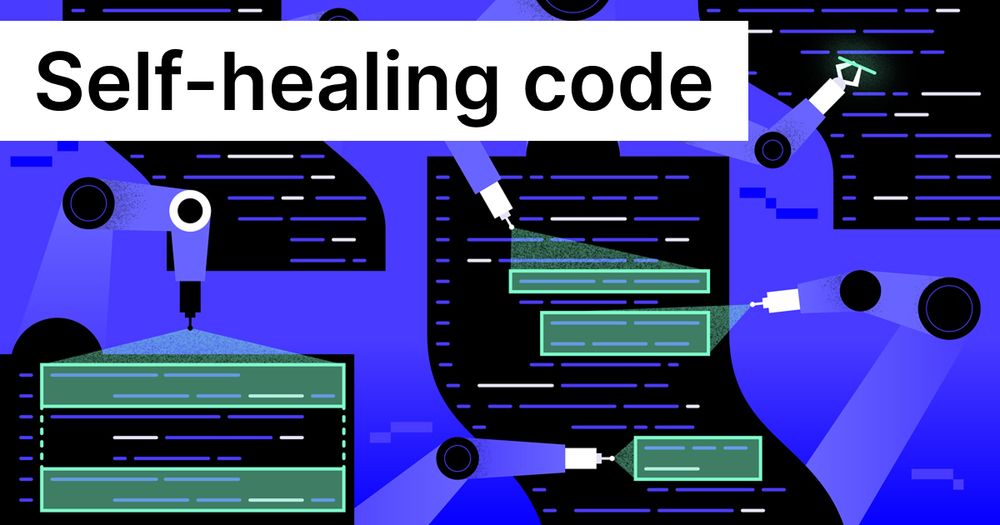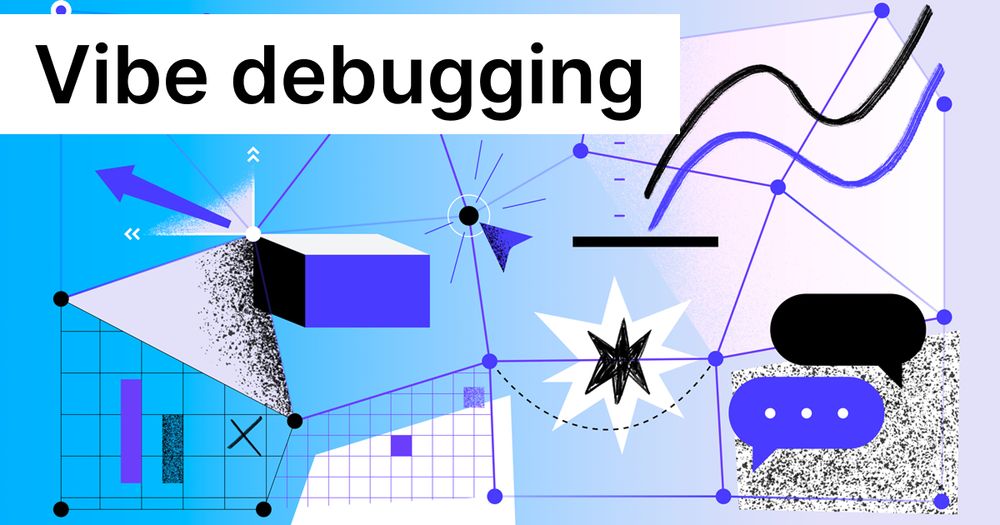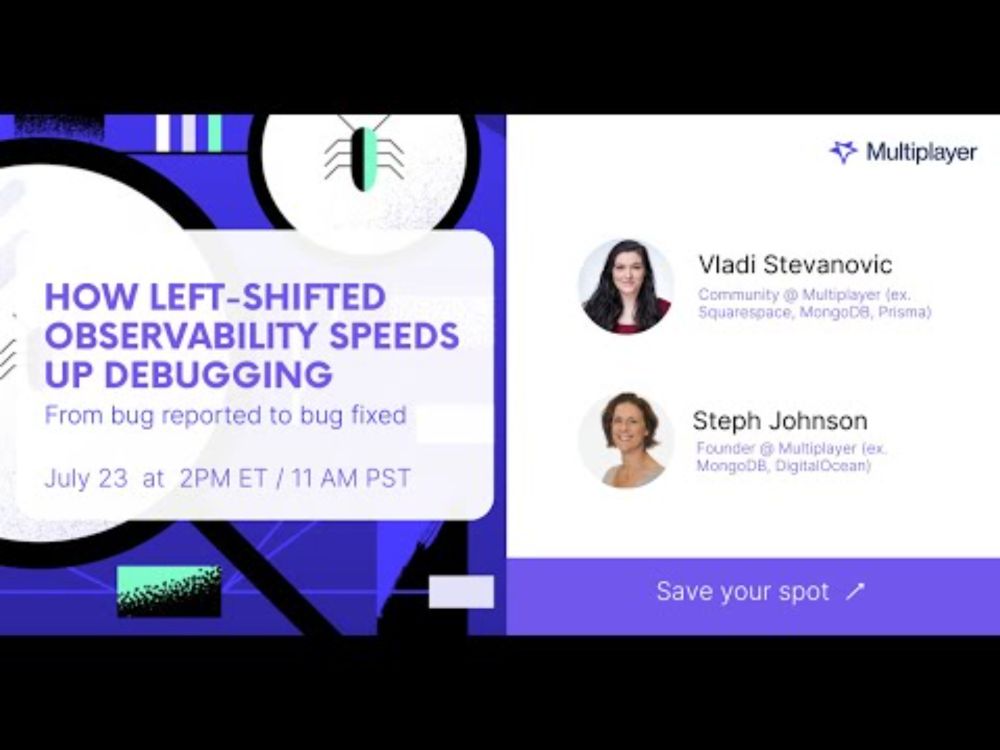👀 How great would it be to push record and never ask “what happened?” again?
But for real.
With backend data, automatically correlated with frontend end screens.
08.08.2025 13:21 — 👍 0 🔁 0 💬 0 📌 0
BUT self-healing doesn’t work without visibility.
You can’t fix what you can’t explain.
And AI can’t propose meaningful fixes without runtime context.
That’s where Multiplayer comes in. 😉
07.08.2025 20:58 — 👍 0 🔁 0 💬 0 📌 0
Self-healing today is less “magic algorithm” and more coordination of solutions, tools, and technologies to observe, reason, fix, deploy.
The result?
🧠 Smart debugging
💥 Faster recovery
🚢 More shipping, less guessing
07.08.2025 20:58 — 👍 0 🔁 0 💬 1 📌 0
...
• ML-powered root cause analysis → identify patterns, detect failures early
• Gen-AI assistants → propose fixes from real bugs
• Automation/orchestration tools → execute mitigations (via APIs, workflows, bots)
07.08.2025 20:58 — 👍 0 🔁 0 💬 1 📌 0
The implementation is the hardest part because it’s not a single tool or technique. It’s a stack:
• Observability platforms → surface anomalies
• Runtime capture systems → full-stack session recordings of the system state and user actions
...
07.08.2025 20:58 — 👍 0 🔁 0 💬 1 📌 0
AI tools brought a resurgence of interest in self-healing because they offer something the old methods didn’t:
☑️ flexible, intelligent recovery paths
☑️ predictive behavior
☑️ remediation based on real system data
07.08.2025 20:58 — 👍 0 🔁 0 💬 1 📌 0
The concept borrows from ideas in fault-tolerant and autonomous systems, aiming to make applications more resilient, especially in complex or distributed environments.
Useful, but brittle. And very manual.
07.08.2025 20:58 — 👍 0 🔁 0 💬 1 📌 0
“Self-healing” originally meant clever, rule-based, hardcoded automations:
⁃ Restart a crashed service
⁃ Switch to a backup DB
⁃ Retry a failed request
Think: graceful degradation, resilient architecture, automated failover systems.
07.08.2025 20:58 — 👍 0 🔁 0 💬 1 📌 0

What is self-healing code?
It’s not a buzzword. It’s a real concept, one that’s been around for decades.
But with AI now in the mix, it's evolving fast. Let’s break it down 🧵👇
07.08.2025 20:58 — 👍 0 🔁 0 💬 1 📌 0
With full context and prompt-optimized input, your AI can suggest accurate, system-aware fixes.
01.08.2025 13:26 — 👍 0 🔁 0 💬 0 📌 0
The solution is simple: receive better AI fix suggestions.
To do that, send your AI IDE full-stack session recordings: frontend screens, backend traces, metrics, logs, and full request/response content and headers.
01.08.2025 13:26 — 👍 0 🔁 0 💬 1 📌 0
Add to that that debugging AI-generated code feels 10x harder because you didn’t write it.
When you write code yourself, you build a mental model. You know the shape of the data, the edge cases, the intent behind each line.
With AI-generated code you inherit logic without understanding it.
01.08.2025 13:26 — 👍 0 🔁 0 💬 1 📌 0
The model doesn’t know your architecture, runtime state, or the exact execution path.
It doesn’t have any awareness of intent or business rules.
In short: the code may look like it works, but that’s not the same as it actually working.
01.08.2025 13:26 — 👍 0 🔁 0 💬 1 📌 0
There are many reasons why AI coding assistants can introduce bugs:
• No system context
• Vague prompts
• Outdated or hallucinated APIs, libraries, methods…
• Happy-path logic only
• No business awareness
• …
01.08.2025 13:26 — 👍 0 🔁 0 💬 1 📌 0

Vibe debugging emerged naturally alongside the rise of vibe coding.
It highlights the difficulties of debugging AI-generated code without fully understanding it.
In short: create 20,000 lines in 20 minutes, spend 2 years debugging
01.08.2025 13:26 — 👍 0 🔁 0 💬 1 📌 0

What is vibe debugging?
If you’ve used an AI coding assistant, you’ve probably done it, even if you didn’t call it that.
Let’s unpack this very unofficial, very real debugging pattern 🧵👇
01.08.2025 13:26 — 👍 0 🔁 0 💬 1 📌 0
It pays to be proactive, especially when data captured at the right moment (and across the full stack) can shave hours off your MTTR.
31.07.2025 16:38 — 👍 0 🔁 0 💬 0 📌 0
Every missing trace, every unlabeled log, every ‘unknown’ in a dashboard … these are debts that will compound during your next production incident.
31.07.2025 16:38 — 👍 0 🔁 0 💬 1 📌 0
99% of debugging time is just trying to get the system to confess.
30.07.2025 18:43 — 👍 0 🔁 1 💬 0 📌 0
Building an internal API integration?
Here’s an example of how you can:
✔️ Chain internal API calls to model real workflows
✔️ Prototype code logic inline
✔️ Add interactive custom visualizations using HTML/CSS/JS
30.07.2025 18:40 — 👍 0 🔁 0 💬 0 📌 0
If your system goes down and the first step is 'open five dashboards,' you don’t have a debugging workflow.
You have a scavenger hunt.
29.07.2025 12:57 — 👍 0 🔁 0 💬 0 📌 0

We’re not saying your system is the problem.
But we’re also not not saying it.
28.07.2025 13:09 — 👍 0 🔁 0 💬 0 📌 0
😍
28.07.2025 13:08 — 👍 1 🔁 0 💬 0 📌 0
YouTube video by TryMultiplayer
How left-shifted observability speeds up debugging
Worth your time, especially if your team is building (and debugging) complex systems: youtu.be/1TLatomEi_A
24.07.2025 09:18 — 👍 1 🔁 0 💬 0 📌 0
Missed our live session on faster debugging workflows?
Check the recording to learn:
🧠 Why observability needs to move left
🐛 How to debug with full-stack context (and no guesswork)
🤖 What AI can actually do to fix bugs
24.07.2025 09:18 — 👍 0 🔁 0 💬 1 📌 0
🔴 We’re live!
Tune in to see:
✔️ Full-stack debugging in action
✔️ How to feed real runtime context into your AI IDE
✔️ What it takes to go from symptom to fix, fast
23.07.2025 17:58 — 👍 0 🔁 0 💬 1 📌 0
Today’s the day!
🐞 Bug reports don’t have to mean Slack threads, log spelunking, and guesswork.
Join us for a live walkthrough of how left-shifted observability + AI-assisted debugging can speed up your entire workflow.
📅 July 23 | 2PM ET | 11AM PT | 8PM CEST
23.07.2025 12:33 — 👍 0 🔁 0 💬 1 📌 0
A next-generation code editor that enables high-performance collaboration with AI and your team.
zed.dev
#GOTO Presents the Brightest Minds in Tech.
Check out GOTO Conferences.
https://gotopia.tech
https://www.youtube.com/@GOTO-
Designer and product manager. Founder of simple.org, healthicons.org, hardproblems.com. Working on public health tech at Resolve to Save Lives: rtsl.org
I have friends everywhere
Chicagoland area
Dogs > people
he/him
Contact info: https://links.mattstratton.com/
#DevRel #DevOps #Weightlifting
Tech's Favorite Auntie
VP of DevRel @ Block
#techgirl1908
👩🏻💻 Software Developer ➡️ Product ➡️ Product Operations
📍 WNY / east-coast energy
🎮 Probably gaming
🗣️ Plenty of opinions
💪🏻 Believes in better
CEO at Multiplayer.app, AI-Powered Debugging for Distributed Systems
Semi-retired technologist. Did k8s, GCE, gtalk and IE. Figuring shit out. Protect Trans kids 🏳️⚧️. Seattle. Signal: jbeda.99 he/him
Cloud native open source at Azure. She/her. Likes snow, bicycles, and @joelaha.bsky.social.
Open Source | DevOps | Kubernetes Contributor | ex-Red Hat, ex-AWS | r/devopsish | Disabled Veteran | LEGO | Corgis | Detroit | He/Him | Views solely mine | https://ChrisShort.net
Principal data engineer at PayIt in KCMO. Data engineering, platform engineering, devops, bicycles, Lego, DIY, KC. Husband. Pop to 2. He/him. Opinions mine. Don't park in bike lanes.
https://linktr.ee/menzenski
Open Source | Isovalent @ Cisco | eBPF | Cilium | author of O’Reilly books on Container Security and Learning eBPF | AWS Container Hero | music @insidernine.bsky.social
Product Manager @microsoft | Creator of bluesky.ms • cmd.ms • idPowerToys.merill.net • Graph X-Ray • 🇦🇺 • 🇱🇰 • Posts my own
http://youtube.com/@merillx
Sign up to my newsletter https://entra.news
cofounder/CTO @honeycombio, co-author of Observability Engineering and Database Reliability Engineering. I test in production and so do you. 🐝🏳️🌈🦄
Sr Staff Engineer supporting agile cultures that let developers build software well & help them learn how to.
Mediating a new scientific revolution associated with the night dream of post-industrial society
any/all
programming and exclamation marks
I have DMs muted from people I don’t follow.
[bridged from https://social.jvns.ca/@b0rk on the fediverse by https://fed.brid.gy/ ]
Microsoft MVP | Coding Architect | .NET Tech Lead | .NET & C# | TypeScript | Fluent Assertions Author | International Speaker | Occasional Trainer | React & VueJS | Event Sourcing Veteran | DDD Designer | TDD Practitioner | Clean Code Writer
Senior Systems Engineer @TriOpSys ⚡ Blogger ⚡ Musician ⚡ Belgian🇧🇪 living in Holland 🇳🇱






